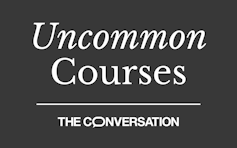This course examines how conflicts arise over borders
Religious, racial and class-based differences often get politicized.


Uncommon Courses is an occasional series from The Conversation U.S. highlighting unconventional approaches to teaching.
Title of course:
Borders and Battles: The Historical Roots of Geopolitical Conflict
What prompted the idea for the course?
I got the idea for the course when I noticed that all of the other history courses I taught – on India, the Middle East and the British Empire – featured major border conflicts. These conflicts arose from a variety of issues, whether the borders were historically ill-conceived, politically disputed or cut across contested resources.
As all of these borders were drawn by the British in the closing days of the empire, they reflect a critical aspect of decolonization. So I decided to abandon the conventional geographical focus of the history course and instead design a course that examines the theme of embattled borders, across different time periods and places.
What does the course explore?
The course encourages students to look at how borders impact people’s everyday lives.
For instance, we discuss how, along the U.S. southern border, the U.S. uses death as a deterrent to migrant border crossing. In the mid-1990s, the U.S. Border Patrol began systematically funneling migrants away from urban areas and into the Sonoran Desert in southern Arizona. There, many succumb to the harsh elements, including temperatures that routinely hit 120 degrees Fahrenheit (49 degrees Celsius), a scarcity of water, and predatory wildlife.
In Israel-Palestine, we examine how the borders between Israel and the occupied territories evolved, why they are contested or enforced and whether they should be redrawn.
The course also explores the 1947 Partition of India, which led to the creation of Pakistan. We talk about the many wars fought between these two nuclear-armed nations, as well as the interpersonal violence and animosity fueled by Partition.
Finally, students investigate the 1921 separation of Northern Ireland from Ireland and how it led to a cycle of violence.
We discuss both IRA terrorism against British civilians and atrocities committed by the British army in Northern Ireland.
For each border conflict, we pay close attention to the imperial and expansionist policies that fueled the formation of borders. Students consider how borders represent historical and imperial legacies.
Why is this course relevant now?
Borders and Battles was first offered during the height of the Trump administration’s family separation policy. This policy separated families trying to enter at the U.S. southern border. Parents were held in federal prisons or deported, while children were placed under the care of the Department of Health and Human Services.
I am now teaching the course against the backdrop of war in Israel-Palestine. Students come to understand how and why border disputes like these developed, how they were aggravated or resolved, and how they affect both individuals and wider society.
I find that students are eager to discuss these issues; they do not need to be sold on their relevance. Many students actually tell me how the course helped them make sense of contemporary conflicts.
What’s a critical lesson from the course?
The most critical takeaway from the course is the dehumanization of the “enemy,” each side by the other. It’s common to all border disputes, no matter where, or when, or why they occur.
This process often involves the politicization of religious, racial and class-based differences. Government officials cast those who defy borders as subhuman, and state policy consistently reflects this bias. Israel’s defense minister, for example, explained that it was necessary to cut off all supplies to Gaza because Palestinians are “human animals.”
What materials does the course feature?
The course material purposefully draws on a variety of formats.
We begin with a book, Jason De Leon’s “The Land of Open Graves: Living and Dying on the Migrant Trail.” De Leon chronicles the journeys of migrants across the U.S. southern border.
We also play an interactive game, Defining a Nation: India on the Eve of Independence, 1945. This game requires students to reenact the partition of the subcontinent. The outcome can be – and usually is – different than the actual historical outcome.
The course ends with a film, “In the Name of the Father,” which looks at the IRA bombing of army pubs in Guildford, England, and the wrongful conviction of the “Guildford Four.”
What will the course prepare students to do?
Many former students have stated that the course better enabled them to understand news broadcasts and keep up with current events.
The course also prepares students for international travel. Some students took the course before traveling to Israel-Palestine. with organizations like Birthright. The course material has even inspired students to become involved in causes related to border disputes. As a direct result of knowledge gained from the course, a handful of students have joined organizations assisting refugees at the U.S. southern border.
Nita Prasad does not work for, consult, own shares in or receive funding from any company or organization that would benefit from this article, and has disclosed no relevant affiliations beyond their academic appointment.
Read These Next
George Washington’s foreign policy was built on respect for other nations and patient consideration
For the nation’s first president, friendliness was strategy, not concession: the republic would treat…
The 17th-century Pueblo leader who fought for independence from colonial rule – long before the Amer
Po'pay, a Tewa religious leader, led the Pueblo Revolt, the most successful Indigenous rebellion in…
Illness is more than just biological – medical sociology shows how social factors get under the skin
Medical sociology examines how social, cultural, political and economic factors shape health in ways…





